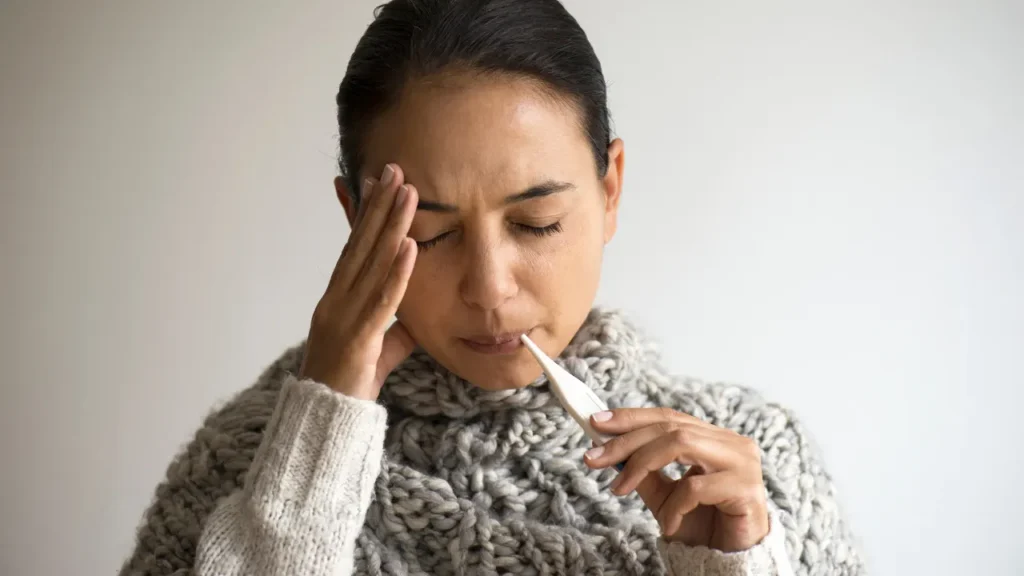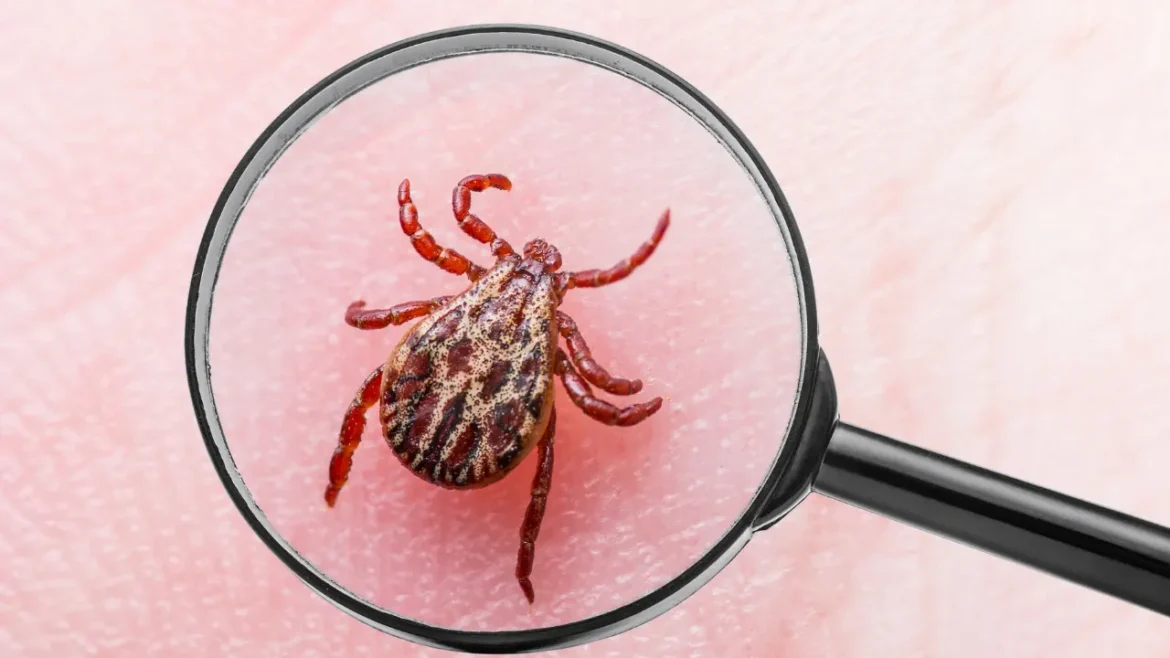Description
Lyme disease primarily refers to the effects of the bacteria Borrelia burgdorferi, which causes Lyme disease and infects humans through the bite of pathogenic black-legged ticks, i.e., Ixodes pacificus or Ixodes scapularis in North America, together with Ixodes ricinus across Europe. In these areas, it is an extremely prevalent disease spread by ticks, and if ignored, it can have an adverse effect on a a plethora of physiological systems.
Lyme disease progresses through multiple phases and exhibits a wide range of clinical symptoms. Erythema migrans, a rash with an oval or circular shape, is the primary indicator of the early stage. This rash usually grows larger over time and frequently resembles a bull’s eye, having a central clearing encircled with a red outer ring. Nevertheless, it is essential to remember that not everyone with Lyme disease gets this rash. Flu-like symptoms like fever, exhaustion, muscle and joint aches, headache, and inflamed lymph nodes are possible early-stage Lyme disorder signs as well.
Most people at this phase recover completely if they receive quick diagnosis and treatment. Lyme disease can progress to later stages without treatment, which can result in serious symptoms that may impact the heart, nervous system, and joints.
You May Also Like:
IMPORTANT INFORMATION ABOUT BULLETPROOF KRILL OIL: A LEADING OMEGA 3 PRODUCT
Lyme disease: Description, Causes, And Treatment Protocol is an original (HealthXWire) article.
Possible Causes
The bacteria Borrelia mayonii and Borrelia burgdorferi, which are spread to people by the bite of infectious black-legged ticks like Ixodes pacificus or Ixodes scapularis in North America, constitute the main causes of Lyme disease. By consuming contaminated animals like mice and deer, these ticks catch the disease. Congenital dissemination from infected women to their unborn children is another unusual mechanism of Lyme disease transmission that can happen.
Exacerbating and Mitigating Factors
Lyme disease can progress and become more severe depending on aggravating and mitigating variables. Co-infections, a compromised immune system, individual susceptibility, insufficient or delayed therapy, and delayed diagnosis can all be aggravating factors. Exacerbating an illness may also be influenced by environmental variables, like tick exposure. Early detection, timely and effective antibiotic treatment, a robust immune system, alterations to one’s way of life, and precautions taken to minimize tick bites are some of the mitigating factors. Lyme disease’s effects can be reduced with adherence to recommended protocols and aggressive management.

Standard Treatment Protocol
Antibiotics are used for treating the infection as part of the conventional Lyme disease treatment plan. The selection of antibiotics and length of treatment are based on the illness stage and the extent of the symptoms. Below, you will find some therapy suggestions that are frequently applied.
Early Localized Lyme Disease or Erythema migrans
The most frequently recommended oral antibiotics are amoxicillin, doxycycline, and cefuroxime axetil. Usually, the treatment lasts between 10 and 21 days. Allergies, age, and considerations specific to each patient may all have an impact on antibiotic selection.
Early Lyme Disease Transmission
Commonly administered oral antibiotics include doxycycline, amoxicillin, and cefuroxime axetil. Individuals with serious symptoms or complications, like carditis or meningitis, can be treated with intravenous antibiotics like penicillin G or ceftriaxone. According to the degree of dispersion and the patient’s response to treatment, the length of treatment may change.
Persistent Symptoms of Late-Stage Lyme Disease
Generally speaking, there is not a widely accepted standard treatment for chronic or persistent Lyme disease, hence its management is debatable. In some circumstances, long-term intravenous or oral antibiotic treatments may be offered, but only after carefully weighing the risks and rewards. It is advised in these situations to consult a medical professional with knowledge of treating Lyme disease.

Treatment Options
Several different treatment options can be taken into consideration besides the typical antibiotic course of action to help manage symptoms and promote overall wellness. These choices include the following:
Over-the-Counter Medications
Ibuprofen and naproxen, are two nonsteroidal anti-inflammatory medications (NSAIDs) that may help with Lyme disease symptoms by reducing inflammation and relieving pain.
Nutritional Supplements
By strengthening the immune system, lowering inflammation, and fostering general well-being, nutritional supplements might prove beneficial in controlling the symptoms of Lyme disease. The following dietary aids have been researched in relation to Lyme disease:
Antioxidants
Inflammation is decreased and cells are protected from oxidative damage by antioxidants. Antioxidants include substances like glutathione, vitamin E, vitamin C, and selenium. These vitamins could strengthen the body’s immune system and accelerate healing.
Vitamin D
Immune system performance is critically dependent on vitamin D. Immune system impairment has been linked to vitamin D deficiency. A healthy immune system and general well-being may be supported by proper vitamin D levels. A healthcare practitioner should be consulted to determine the proper amount, as taking too much vitamin D might have negative effects.
Probiotics
Healthy gut microbiota is supported by probiotics, which are good bacteria. They are noted to potentially support the restoration of gut function which antibiotic therapy can disturb in Lyme disease sufferers. Probiotics like Bifidobacterium and Lactobacillus strains, which enhance immune function, may assist with maintaining a healthy balance of gut flora.
Omega-3 Fatty Acids
Omega-3 fatty acids, which are also present in flaxseeds, walnuts, and fatty fish like mackerel and salmon, possess anti-inflammatory qualities. They have the ability to promote cardiovascular health and assist in reducing Lyme disease-related inflammation. One option for omega-3 supplementation is fish oil or supplements made from algae.
Magnesium
Magnesium has numerous crucial functions within cellular processes and can also help people with Lyme disease suffering from cramps and muscular spasms. Supplemental magnesium may improve how well muscles work and minimize cramping and discomfort.
Coenzyme Q10
Antioxidant Coenzyme Q10 (CoQ10) is vital for the cellular process of producing energy. It can aid in reducing fatigue, which can be a typical symptom of Lyme disease. Using CoQ10 pills is widely considered to maintain energy levels.
Herbal and natural remedies
Although dietary supplements could have supportive advantages, they shouldn’t take precedence over the prescription antibiotic regimen for Lyme disorder. They are designed to be utilized as supplemental therapies to improve overall wellness and health during the healing process. Individual reactions to such supplements may differ, making it crucial to keep track of their results and get advice from a healthcare provider for their specific needs.
People with Lyme disease frequently look to herbal and natural treatments as additional therapies or as a substitute for standard treatment. Some patients have expressed benefits from these treatments, although their effectiveness has not been thoroughly validated by rigorous scientific investigations. Following are several herbal and all-natural treatments that have been researched in relation to Lyme disease:
Japanese Knotweed or Polygonum cuspidatum
A plant known as Japanese knotweed may have antibacterial and anti-inflammatory effects. It contains resveratrol, which has been investigated for potential impacts on Borrelia burgdorferi, the bacteria which triggers Lyme disease. Some people utilize Japanese knotweed as an additional herb in the treatment of Lyme disease.
Cat’s Claw or Uncaria tomentosa
Traditional South American medicine uses the plant cat’s claw. It has been researched for its potential to modulate the immune system and reduce inflammation. Cat’s claw is used by some people to boost their immune systems and lessen Lyme disease-related inflammation.
Garlic or Allium sativum
Garlic is known for its antimicrobial and immune-boosting effects. It may prove useful in the fight against microbiological illnesses, such as Borrelia burgdorferi. Although garlic can be utilized raw or in the form of a supplement, research on its ability to treat Lyme disease is limited.
Andrographis or Andrographis paniculata
Ayurvedic and traditional Chinese medicine both frequently employ plant andrographis. Its abilities to combat inflammation and microbes have been researched. Although more studies are required to determine its effectiveness, some people with Lyme disease utilize the herb to provide supportive treatment.
Samento or Uncaria tomentosa
An increasingly popular alternative treatment for Lyme disease is samento, a particular variety of cat’s claw extracts. Though its effectiveness is still debatable, there isn’t much scientific data to back it up.
Essential Oils
Tea tree oil, clove, and oregano are a few essential oils whose antibacterial qualities have been researched. However, their efficacy in curing Lyme disease has yet to be well proven, and because of the possibility of irritation to the skin or allergic responses, caution must be adopted.
Herbal and natural therapies should always be used carefully and after consulting a healthcare provider because they may have adverse reactions, interact with certain drugs, or be inappropriate for some people. Furthermore, herbal goods’ standardization and quality may vary, therefore it is essential to select reliable suppliers and items.
Lifestyle Modifications
A healthy lifestyle involving regular exercise, stress reduction, and adequate sleep can promote a strong immune system that is functioning correctly.
Above all other considerations, the safety and effectiveness of supplementary treatments and natural remedies ought to be reviewed with a healthcare provider, even though some people may experience symptom alleviation and benefits from them. In order to ensure the most suitable and efficient course of action, specific treatment strategies need to be created in conjunction with skilled healthcare professionals, as Lyme disease has been a complex condition.

Conclusion
Understanding Lyme disease symptoms, such as a distinctive rash, fever, and fatigue, and immediately seeking medical help if you suspect a tick bite or experience these symptoms, are crucial steps. It is important to realize that although home remedies may temporarily alleviate symptoms, they do not address the underlying infection and may even exacerbate the condition. Always consult with healthcare professionals to determine a factual diagnosis and appropriate treatment of Lyme disease. By taking preventive measures like wearing protective clothing, using insect repellent, and promptly seeking medical attention if you suspect exposure to ticks, you can greatly reduce the risk of contracting Lyme disease and ensure your health remains intact.

Additional resources for further reference
https://www.aad.org/public/diseases/a-z/lyme-disease-signs
https://my.clevelandclinic.org/health/diseases/11586-lyme-disease
https://emedicine.medscape.com/article/330178-overview
Important Note: The information contained in this article is for general informational purposes only, and should not be construed as health or medical advice, nor is it intended to diagnose, prevent, treat, or cure any disease or health condition. Before embarking on any diet, fitness regimen, or program of nutritional supplementation, it is advisable to consult your healthcare professional in order to determine its safety and probable efficacy in terms of your individual state of health.
Regarding Nutritional Supplements Or Other Non-Prescription Health Products: If any nutritional supplements or other non-prescription health products are mentioned in the foregoing article, any claims or statements made about them have not been evaluated by the U.S. Food and Drug Administration, and such nutritional supplements or other health products are not intended to diagnose, treat, cure, or prevent any disease.
Table of Contents


